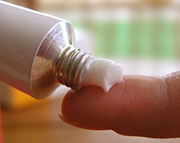Duration and frequency of topical corticosteroid use predicts rebounding triad
WEDNESDAY, July 8, 2015 (HealthDay News) — A subgroup of patients with dermatitis who discontinue topical corticosteroids (TC) after long-term treatment have clinical rebounding triad manifestations, according to a study published in the July issue of the Journal of Dermatology.
Xiao Xiao, from Xiangya Hospital in Changsha, China, and colleagues examined diagnostic criteria among patients with facial corticosteroid-dependent dermatitis (FCDD). Two hundred sixty-eight patients with FCDD were assessed after TC cessation to determine distinctive rebounding triad manifestations (severe itching, dryness, and burning). Eighty-three chronic dermatitis patients with rebounding triad after TC discontinuation were also enrolled and added to patients with FCDD who presented with triad symptoms. Triad-positive patients were compared to those without triad.
The researchers found that 85 patients with triad manifestations after TC discontinuation showed longer and more frequent TC use (both P < 0.0001). After adding 83 dermatitis patients who experienced triad after TC cessation, similar results were obtained. Independent predictors of rebounding triad after TC cessation included mean duration of TC use (odds ratio, 1.83) and mean frequency of TC use (odds ratio, 2.802).
“The clinical rebounding triad described in this study may be a critical factor for the diagnosis of FCDD,” the authors write. “Mean duration and frequency of TC use were found to be independent factors determining the occurrence of the triad of symptoms.”
Copyright © 2015 HealthDay. All rights reserved.








